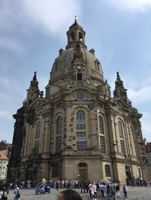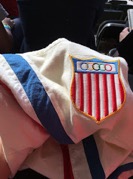by Erin Langermeier and Mossimo Chavez
Hello! It’s Erin and Mossimo here with today’s class blog!

Today is our sixth day of the European Model of Sport trip. We traveled from Prague, Czech Republic to Berlin, Germany with a short pit stop in Dresden, Germany. We will be sharing what we learned on the walking tour in Dresden and our experience at the Berlin Olympic Stadium and team handball game.
Our first item on today’s agenda was a city walking tour in Dresden, Germany. It was about a two-hour bus ride from Prague, Czech Republic to Dresden, Germany and we all slept the whole bus ride there. Our tour started at the Dresden center opera house, which was built in 1841 and was named after the architect who constructed it, Gottfried Semper. Here is a picture of the opera house on the right.

In 1869, the Semper opera house was destroyed by a fire caused by some of the workers in the building and when it was being reconstructed, Semper created the blueprints. As you can see in the picture above there is also a statue in the middle of the square. This statue is a representation of the equestrian statue of Saxon King John, who was also known as the “professor of the throne”, because he was so intelligent and could speak several different languages. The town square also had an old catholic church that was built in the mid 18th century.
After, we proceeded to the Courtyard, Zwinger.

Many festivities took place in this courtyard during the 17th, 18th, and 19th century. The arch with the crown on top (pictured to the left) represented one line of fortification, whereas the Semper gallery behind where we were standing represented the other line of fortification. During 1695 this location hosted the parade of gods with many unique floats and in 1710 the Courtyard, Zwinger also hosted the ladies’ tournament. Many of the structures and statues in this courtyard are composed of rich porcelain.
Our group continued on the walking tour to the garden of the residential palace located in the city. Built in 1500 but destroyed and later reconstructed, this palace was originally where King Augusta allowed his mistresses to live. Later it was passed on to the king’s son to live there with his family. The Taschenbergpalais was destroyed in World War 2 and in 1992 it was transformed into a luxurious hotel. Right across the street from the Taschenbergpalais was the palace of the king. It was destroyed by World War 2 (like many of the architecture in Dresden) then rebuilt in the years following. It was very interesting that the ceiling of one of the smaller courtyards in the palace is made of the same material as the Allianz Arena.
This old market is the home of the Church of the Holy Cross (pictured to the left), which was destroyed around 1750 by the Prussians. When the Prussians raided the city of Dresden, the Church of the Holy Cross was one of the main pieces of architecture that they intended to destroy. We were informed that almost all of the buildings in Dresden are post-war architecture. Next was the other side of the palace. Around 1539 the king’s church right outside of this palace became protestant. King Augusta wanted to be the king of Poland and in order to do so he needed to convert himself from catholic to protestant, so he made the church protestant.
After we toured the old market, we moved onto the Procession of Princes

and the old jousting arena.

The Procession of princes is 300 feet long and consists of 35 rulers, who are all from the same family. The order of the princes is oldest to youngest. This was not the original version; they had to reconstruct the procession of princes, because the material they used before was starting to wear down and kept falling off the wall. The procession of princes included Friedrich D Gebissene (1307-1324) who was also known as “Friedrich the bitten”. This was because his mother had bit him on the neck as she left the palace for good to leave her mark and show her awful husband that she had been of the real leader of the throne. 1918 was the year of the last reigning king. The jousting arena was used during the 16th century. There was a building behind us in this picture that was used as a stable and the armory was right next to the stable. These buildings were destroyed in World War 2 and they were recreated to be a museum for people to visit.
Our last stop of the walking tour was the New Market Square which included the Church of our Lady. The old version of this church was gothic, but the new version represented the shape of a bell. In 1760 the church was destroyed by the Prussians. The church was actually still standing after air raids, but it eventually collapsed two days later. 1994 was when reconstruction began and it was finished 10 years later in 2004. The church of the New Market Square is pictured below.

After a walking city tour of Dresden and a quick lunch, we hopped back on the bus for a three hour ride to Berlin. We drove straight to the Olympiastadion from the 1936 summer Olympic games for a tour around the facility and a lecture from an Olympic historian. These games were at the height of Hitler’s reign so he used to games as propaganda to promote the views and ideas of the National Socialist German Workers’ Party, also known as the Nazi Party. The original stadium was able to hold over 100,000 fans but that number has been reduced to 75,000 because of the implementation of individual seating. During the tour we were able to check out where Hitler’s balcony was where he would congratulate and shake hands with gold medal winners. Here is the view of where he and his associates would be sitting.

The final part of the stadium tour was near the Olympic torch and the engraved names of the Olympic winners in the 1936 games. Included on the list of winners is four-time gold medalist and former Buckeye, Jesse Owens. We made our way back towards the entrance of the stadium for a lecture about Jesse Owens and the importance of his success in the 1936 games. We learned about Owens’ relationships with other athletes, specifically Lutz Long and how he was disrespected by Adolf Hitler. Our lecturer showed us a couple amazing pieces of memorabilia including replica jerseys worn by both the United States team and the German team from those games as well as Luz Long’s silver medal in long jump.



After the Olympiastadion, we traveled over to a team handball game between Füchse Berlin and TuS N-Lübbecke. Similar to the Bayern Munich basketball game, the fans are very loud and were bringing the energy from the beginning of the game to the end. Back in the States I’ve never experienced a crowd atmosphere like I have at the sporting events we’ve attended here in Europe. The majority of the group has never watched handball so this was a completely new experience for all of us; trying to learn the rules on the fly and figure out what was going on. Füchse Berlin came out on top with a 26 to 20 win. Here is a picture of the Max-Schmeling-Halle arena that they play in, with a maximum capacity of around 12,000 people.

After a long day of traveling and touring Dresden and Berlin for the first time, we all grabbed dinner and were ready to rest up for the next day. That’s all for day six from Erin and Mossimo! Hope you enjoyed reading about our trip so far!
